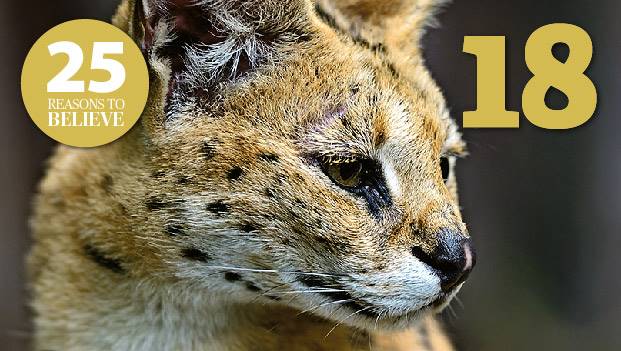
As South Africa celebrates a generation of freedom, Anglo American acknowledges its deep roots in the country and looks ahead to its contribution in the next 25 years and beyond.
Over the next five weeks experience 25 Reasons to Believe with City Press as we explore the economy, job creation, enterprise development, health, land reform, sustainability, education, technology and – most important of all – the communities
WILDLIFE FLOURISHES ON THE COALFIELDS
A proposed ground-breaking study on the population ecology of serval (Leptailurus serval) in the Mpumalanga coalfields aims to investigate the conservation potential of Anglo American’s Coal South Africa business’ Isibonelo Colliery.
Rehabilitated landscapes can play an important role in conservation and biodiversity, and this research can act as a powerful case study for similar landscapes globally.
Pilot studies thus far have shown Isibonelo Colliery is home to a surprisingly large number of animal species, including otter, water mongoose, bush pig, porcupine, spotted genet, common duiker and even the near-threatened brown hyena. Serval, a mid-sized wildcat species, seems to be particularly abundant on rehabilitated land in the area.
In north Africa, the serval is known to appear in Morocco and has been reintroduced in Tunisia, but is feared to be extinct in Algeria. The animals inhabit semi-arid areas and cork oak forests close to the Mediterranean Sea, but avoid rainforests and arid areas.
These cats are widespread in southern Africa.
They prefer areas with cover, especially riparian areas such as reedbeds and wetlands. However, they often occur in tall grass areas in proximity to water bodies, and seem to tolerate agricultural and industrial landscapes that provide enough cover.
In South Africa, servals have been recorded in the Free State, the eastern Northern Cape and in southern North West
In Namibia, they are present in the Khaudum and Mudumu national parks. Together with the African Institute for Conservation Ecology and Genetics, the Isibonelo mine has embarked on a five-year research project that will see carnivore and wetland specialists investigate the existence of this serval and other mammal species in these modified landscapes. The study will include an estimation of the site’s serval population, feeding ecology and spatial ecology.
Population ecology will be investigated with the aid of 50 camera traps and spatial ecology with the aid of high-resolution GPS collars. To date, 148 pictures of serval have been recorded on the mine’s 2 000-hectare site – suggesting that serval seem to be fairly common, says Roze Reiners, a rehabilitation superintendent at Anglo American’s Coal South Africa business.
The study, which will be registered as a project with the Mpumalanga Tourism and Parks Agency, will be overseen by Dr Lourens Swanepoel, a senior researcher at the University of Venda. Field work will be conducted by student ecologists from the University of Venda and the University of the Free State.
“While research and public perception generally focus on mining’s negative impact on fauna and flora, scientists globally are starting to understand how unused and rehabilitated landscapes can create unique environments that have an important role to play in conservation,” says Reiners.
The serval research will initially focus on selected portions of mine property. Later the study will expand to agricultural areas around the mine. Reiners says the high population of serval indicates that there is a sustainable food source for the species. Serval primarily feed on rats and mice, and do not pose a threat to livestock, as many farmers mistakenly believe.
“The value of modified industrial landscapes is slowly emerging as a theme in academic and conservation circles,” says Reiners.
“We believe that this study will greatly improve our knowledge about the conservation value of modified industrial landscapes for various species, and that these should be considered in future conservation planning.”
BIODIVESITY: A GOOD VINTAGE
At Vergelegen in Somerset West in the Western Cape, which earlier this month won the best wine estate in Africa gong at the annual World’s Best Vineyards awards, 50 rare bontebok are thriving.
The 319-year-old wine estate, which was acquired by Anglo American in 1987, plays an important role in protecting biodiversity in the area.
Of the 3 000-hectare estate, 1 900ha became a private nature reserve last year, and the herds of bontebok – once endemic to the area but hunted to near extinction – are one of the estate’s drawcards, bringing 100 000 visitors to the area every year.
“We first welcomed 13 bontebok to the estate about 10 years ago,” says Vergelegen CEO Don Tooth.
“Care for the environment is key at the estate. Vergelegen was the first Biodiversity & Wine Initiative champion back in 2005, and we are committed to making the estate a prime destination for future generations to enjoy.”
Vergelegen’s award this month is significant as the annual World’s Best Vineyards list, which this year analysed 1 500 wineries from 17 countries, is designed to raise the profile of wine tourism. The winner overall this year was Zuccardi Valle de Uco in Argentina, with Vergelegen coming in at number 34 overall – the top spot for a South African winery and one of only three South African wineries to make the prestigious top-50 list.
“We are absolutely delighted by this award,” said Tooth.
“The Vergelegen team is committed to building South Africa’s reputation as a producer of world-class wines, and this win is an acknowledgment of that passion.
“Tourism is a vital part of our economy, outperforming many key industries in job creation, so this is not only a proud moment for Vergelegen, but for the South African wine and tourism sectors overall.”
Vergelegen’s previous accolades include the International Best of Wine Tourism, Cape Winelands, awarded in 2016 for an unprecedented fifth time.




 Publications
Publications
 Partners
Partners








